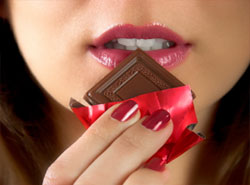Chocolate: What is the Love Connection?
Chocolate. Dark, white, milk. Pralines, truffles or nugget. No matter what its form, its creamy dark goodness is virtually synonymous with Valentine’s Day. Packaged  up in that shiny red, heart-shaped box, it all but screams, “I love you.”
up in that shiny red, heart-shaped box, it all but screams, “I love you.”
Come February, chocolate sales boom. But when did chocolate become the penultimate Valentine’s Day gift? And how did cocoa beans grow into the symbol of love?
The cocoa connection dates back to ancient history. In fact, chocolate has been around almost as long as man. In 1500 BC, the Olmec Indians grew the first cocoa beans as a domestic crop. At the beginning of the Common Era, Mayan elders began enjoying a drink made from ground cocoa beans – a tradition that continued among society elite well into the 18th century.
During the Middle Ages, Spaniards added cane sugar and other flavorings to sweeten their cocoa drinks. And then in the late 1600s, chocolate emporiums opened across Europe, serving up the first solid versions – baking cocoa in cakes and eventually mixing it into candies as well.
All the while, chocolate was gaining popularity not only for its decadence, but also for its reputed aphrodisiac properties. Today, we know that chocolate contains phenylethylamine, a naturally occurring amino-acid – the same one that we humans release when we are falling in love. Chocolate also contains tryptophan, a building block of serotonin, which is one of the brain chemicals involved in sexual arousal. No wonder eating chocolate feels so good. And with researchers now touting the heart-healthy benefits of eating dark chocolate, what’s not to love?
But even before modern science, chocolate enthusiasts have been clued in to the good feelings that come from eating (or imbibing) cocoa beans. The Aztec emperor Montezuma was said to have drank copious amounts of the ground beans to increase his sexual prowess. And during Mesoamerican marriage ceremonies, the couple is said to have shared a ritual cup of cocoa, believing that it would increase their luck in love.
It should be no surprise, then, that chocolate has become – or rather, remained – an edible symbol of love. Nor is it too surprising that chocolate makers have capitalized on this natural association.
The first to seize the opportunity was Richard Cardbury – the famous British chocolatier – who, in the 1860s, designed and sold the first heart-shaped box of chocolate candy. Just in time for Valentine’s Day. Four decades later, the American chocolate maker Whitman upped the heart-shaped box ante with a brilliant improvement: a map inside the lid describing the filling in each piece.
The introduction of that first Cadbury heart-shaped box has catapulted a 150-year tradition of sharing chocolate with your sweetheart on Valentine’s Day. With more than 35 million boxes of chocolate are sold each year, simple chocolate goodness has become the ultimate gift of love.



